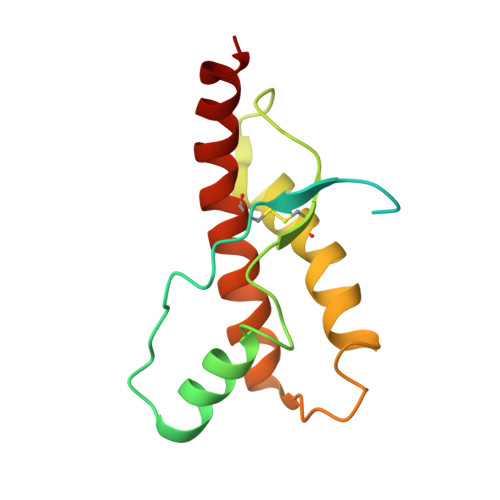Unique structural characteristics of the rabbit prion protein
Wen, Y., Li, J., Yao, W., Xiong, M., Hong, J., Peng, Y., Xiao, G., Lin, D.H.(2010) J Biol Chem 285: 31682-31693
- PubMed: 20639199
- DOI: https://doi.org/10.1074/jbc.M110.118844
- Primary Citation of Related Structures:
2FJ3, 2JOH - PubMed Abstract:
Rabbits are one of the few mammalian species that appear to be resistant to transmissible spongiform encephalopathies due to the structural characteristics of the rabbit prion protein (RaPrP(C)) itself. Here, we determined the solution structures of the recombinant protein RaPrP(C)-(91-228) and its S173N variant and detected the backbone dynamics of their structured C-terminal domains-(121-228). In contrast to many other mammalian PrP(C)s, loop 165-172, which connects β-sheet-2 and α-helix-2, is well-defined in RaPrP(C). For the first time, order parameters S(2) are obtained for residues in this loop region, indicating that loop 165-172 of RaPrP(C) is highly ordered. Compared with the wild-type RaPrP(C), less hydrogen bonds form in the S173N variant. The NMR dynamics analysis reveals a distinct increase in the structural flexibility of loop 165-172 and helix-3 after the S173N substitution, implying that the S173N substitution disturbs the long range interaction of loop 165-172 with helix-3, which further leads to a marked decrease in the global conformational stability. Significantly, RaPrP(C) possesses a unique charge distribution, carrying a continuous area of positive charges on the surface, which is distinguished from other PrP(C)s. The S173N substitution causes visible changes of the charge distribution around the recognition sites for the hypothetical protein X. Our results suggest that the ordered loop 165-172 and its interaction with helix-3, together with the unique distribution of surface electrostatic potential, significantly contribute to the unique structural characteristics of RaPrP(C).
Organizational Affiliation:
NMR Laboratory, Shanghai Institute of Materia Medica, Chinese Academy of Sciences, Shanghai 201203, China.














